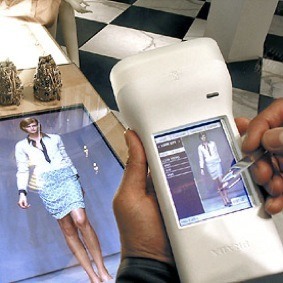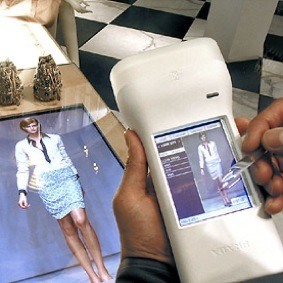
Interactive retailing, circa 2001, still being applied today
January 9, 2012 by Dave Haynes
Google Alerts flagged a story for me the other day about an interactive retailing thing in a Prada store in New York, and my first reaction to it was surprise that the technology looked so clunky. Then I realized the story was from 2001, not 2011.
Digital Wellbeing Labs has a case study up about the project:
 (In) Early 2000 IDEO was invited to join the team of OMA / AMO architects to develop the interaction architecture for the Prada “epicenter” stores in New York and Beverly Hills, designed by Rem Koolhaas and his team at OMA / AMO.
(In) Early 2000 IDEO was invited to join the team of OMA / AMO architects to develop the interaction architecture for the Prada “epicenter” stores in New York and Beverly Hills, designed by Rem Koolhaas and his team at OMA / AMO.
The brief was to investigate the most cutting edge technologies available, understand possible applications in a high-end fashion store sales environment and adapt useful technologies to create a luxurious customer experience. Over 18 months an eclectic team of architects interaction designers, industrial designers and software and mechanical engineers developed a sales infrastructure that transparently linked individual merchandise, stock numbers, sizes, staff members, displays, locations and customer cards throughout the store.
This was one of the most exciting projects I have ever been involved with. Early on in the project, as a small team at IDEO we rapidly developed a range of ideas together with OMA/AMO, based on the outcome of various brainstorm sessions and created a set of hypothesis which formed the basis for sketches, rough physical prototypes of a dressing room, including early behavioural tests of the software for the magic mirror. The hypothesis were then tested as part of Human Factors studies during observations at Prada stores. This was followed by a sequence of design proposals and prototypes and involved an increasingly complex network of design and technology collaborators till the final version was implemented more than a year later.
The technology integrated into the project included RFID tags and smartcards, handheld scanners and looked tools, interactive touchscreens and smart mirrors. When a shopper brought clothing into a dressing room, a scanner picked up the SKUs of the clothing and displayed it on a screen in the change area.
Much of what was tried then has since been applied to iPod Touch and iPads, as well as other handheld devices, in retail, as well as to bigger, better and faster displays and touch apps
Unfortunately, the article doesn’t go into outcomes of the project, but we can very safely assume that 10 years on that equipment has been supplanted. Interesting, though, to see ideas going back that far that are still being raised and tried today.
[youtube id=”3pXNYciHCLc” width=”600″ height=”350″]



Leave a comment